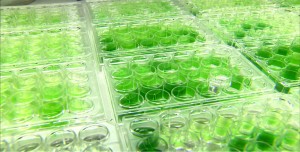
10 News has an interview with Dr. Stephen Mayfield, a San Diego researcher who believes that algae biofuel will be available to the public in ten years’ time.
Dr. Mayfield works at the San Diego Center for Algae Biotechnology, a leading hub of research in the U.S. The center last year received a $4 million state grant to train workers to join the biofuel industry.
The algae sell is enticing: 5,000 gallons of fuel per year; rapid growth and little water needed; it grows in the desert; it does not compete with food crops; and so on. It may sound too good to be true – but who knows?
Algae for hydrogen
Algae biodiesel is also news at MIT, which released a press release regarding breakthrough research in the field.
MIT said that Shuguang Zhang, associate director of MIT’s Center for Biomedical Engineering, and postdoc researchers Iftach Yacoby and Sergii Pochekailov, in a collaboration with Tel Aviv University in Israel and the National Renewable Energy Laboratory in Colorado, have found a way to use bioengineered proteins to flip algae’s preference from sugar to hydrogen.
“The algae are really not interested in producing hydrogen, they want to produce sugar,†Yacoby said – the sugar is what they need for their own survival, and the hydrogen is just a byproduct. But a multitasking enzyme, introduced into the liquid where the algae are at work, both suppresses the sugar production and redirects the organisms’ energies into hydrogen production.â€
The enzyme increases hydrogen production by 400% but sugar production is not completely suppressed otherwise the organism would die.
The potential application of the system is to produce hydrogen on a large scale using water and sunlight. The hydrogen would then be used in a fuel cell or to power a vehicle, or combined with carbon dioxide to make methane or other fuels in a renewable, carbon-neutral way.
A more detailed description of the work will appear online this week in the Proceedings of the National Academy of Sciences. The research was supported in part by a European Molecular Biology Organization postdoctoral fellowship, the Yang Trust Fund and the U.S. Department of Energy’s National Renewable Energy Laboratory.
The researchers highlight the simplicity of the process as one of its selling points. Algae exists anywhere in the world so developing countries could benefit as well. Besides, no toxic materials are involved in this method.






This sounds promising. The scale up for mass production might be a task, but I’m sure the industry is actively searching for solutions. If their projections are viable, they could revolutionize enerrgy production and usage across the board with various sources. We will be keeping a close eye, thanks for reporting!